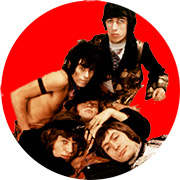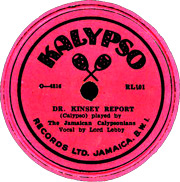J J Cale: Call The Doctor (1972)
 J J Cale has been a personal hero of mine for a very long time, and through his music I’ve come to appreciate a lot of different styles. Plus, he’s also a role model: sound engineer as well as musician and writer, he created a sound (called The Tulsa Sound after his hometown). A sound so elusive that Eric Clapton, perhaps his most devoted fan, asked Cale to costar in his 2006 album The Road to Escondido specifically to try to figure out how he got it (hint: he probably didn’t). Naturally is Cale’s first album, mostly homemade. It features a lot of amazing muddy sounds, a drum machine (the original Rhythm Ace), and many great tunes: After Midnight (also a hit for Clapton, who covered it in his first solo album in 1970), Crazy Mama, Call MeThe Breeze (later recorded by Lynyrd Skynyrd and Johnny Cash), Bringing it back (covered by Kansas) and Clyde (another gem, covered by the legendary Dr. Hook & The Medicine Show and a 1980 country hit☊ for Waylon Jennings, but the original☊ is still the best).
J J Cale has been a personal hero of mine for a very long time, and through his music I’ve come to appreciate a lot of different styles. Plus, he’s also a role model: sound engineer as well as musician and writer, he created a sound (called The Tulsa Sound after his hometown). A sound so elusive that Eric Clapton, perhaps his most devoted fan, asked Cale to costar in his 2006 album The Road to Escondido specifically to try to figure out how he got it (hint: he probably didn’t). Naturally is Cale’s first album, mostly homemade. It features a lot of amazing muddy sounds, a drum machine (the original Rhythm Ace), and many great tunes: After Midnight (also a hit for Clapton, who covered it in his first solo album in 1970), Crazy Mama, Call MeThe Breeze (later recorded by Lynyrd Skynyrd and Johnny Cash), Bringing it back (covered by Kansas) and Clyde (another gem, covered by the legendary Dr. Hook & The Medicine Show and a 1980 country hit☊ for Waylon Jennings, but the original☊ is still the best).
Call The Doctor is a minor J J Cale pearl. It tells of the misery of love gone bad: “A shady lady took all my bread, ravished my body, lord, and messed with my head. I don’t know but I’ve had my fill, call the doctor and tell him I’m ill.” The arrangement is minimal and perfect, the brass section adds drama to the narration, while the rest of the band (guitar, bass mixed upfront and drums) swings away. And then there’s Cale’s vocal style, so cool and relaxed – yet perfectly on the beat.
buy from amazon • buy from itunes • play on spotify
The Rolling Stones: Dear Doctor (1968)
 The Rolling Stones have been through it all, and their repertoire is large, and quite varied (from Blues to Disco, via R’n’r), despite their sound being pretty consistent, from a certain point on. A repertoire so vast it can be mapped in many different ways: chronologically (the obvious way), comparatively (there must be dozens of Satisfaction versions, from ’65 to tomorrow night’s) or by genre. It’s a task for Pop musicologists, but unfortunately this isn’t a very rewarding job anymore (unless you’re an authority on Taylor Swift). Fortunately we have the internet now, so people can create musical Pop culture objects – albeit sometimes illegally. It’s the case of a 23 songs compilation, The Rolling Stones Have A Country Heart, that surfaced on the Usenet newsgroups sometimes in 2012. Someone simply collected all the Country numbers of the band, and bundled them under that title (something that anyone could do legally, through a streaming service, simply assembling a playlist). The result is startling: a beautiful, unusual but very coherent country album, with hits like Far Away Eyes♾ (Some girls, 1978) and Wild Horses☊ (1971, from Sticky Fingers), crowd pleasers like Sweet Virginia♾ (Exile On Main Street, 1972) and Country Honk☊ (from Let It Bleed, 1969, the acoustic version of Honky tonk women), and more obscure material like Dear Doctor (from Beggars Banquet, 1968).
The Rolling Stones have been through it all, and their repertoire is large, and quite varied (from Blues to Disco, via R’n’r), despite their sound being pretty consistent, from a certain point on. A repertoire so vast it can be mapped in many different ways: chronologically (the obvious way), comparatively (there must be dozens of Satisfaction versions, from ’65 to tomorrow night’s) or by genre. It’s a task for Pop musicologists, but unfortunately this isn’t a very rewarding job anymore (unless you’re an authority on Taylor Swift). Fortunately we have the internet now, so people can create musical Pop culture objects – albeit sometimes illegally. It’s the case of a 23 songs compilation, The Rolling Stones Have A Country Heart, that surfaced on the Usenet newsgroups sometimes in 2012. Someone simply collected all the Country numbers of the band, and bundled them under that title (something that anyone could do legally, through a streaming service, simply assembling a playlist). The result is startling: a beautiful, unusual but very coherent country album, with hits like Far Away Eyes♾ (Some girls, 1978) and Wild Horses☊ (1971, from Sticky Fingers), crowd pleasers like Sweet Virginia♾ (Exile On Main Street, 1972) and Country Honk☊ (from Let It Bleed, 1969, the acoustic version of Honky tonk women), and more obscure material like Dear Doctor (from Beggars Banquet, 1968).
The song, like the previous one, is the lament of a broken heart. But the fake back porch arrangement, the overall attitude, and the spoken part in falsetto at the end, make it sound like the Saturday Night Live version of Country music. Something even Jagger has acknowledged: “The country songs, like Factory Girl or Dear Doctor, on Beggars Banquet were really pastiche. There’s a sense of humour in country music anyway, a way of looking at life in a humorous kind of way – and I think we were just acknowledging that element of the music.” (from the song’s Wikipedia page)
buy from amazon • buy from itunes • play on spotify
Lord Lebby and The Jamaican Calypsonians: Dr Kinsey Report (1955)
 Don’t be fooled: you think it’s Calypso, but is not. This is Mento, very similar but from Jamaica (Calypso is from Trinidad & Tobago). The two genres share many similarities (and to add to the confusion, during the Calypso international explosion in the 50s, many jamaican artists used this term instead of the less known Mento – like the oxymoronic Jamaican Calypsonians that play this song). In fact, the most famous Calypso song ever, Harry Belafonte‘s 1956 hit Day-O (The Banana Boat Song)☊, is actually Mento (Belafonte is Jamaican). A common trait is the use of music as social commentary: “Calypso evolved into a way of spreading news around Trinidad. Politicians, journalists and public figures often debated the content of each song, and many islanders considered these songs the most reliable news source.” (from the Calypso entry on Wikipedia). This is a fantastic story, and artists like Lord Kitchener and Roaring Lion (born in 1908) are certainly the precursors of contemporary MCs*.
Don’t be fooled: you think it’s Calypso, but is not. This is Mento, very similar but from Jamaica (Calypso is from Trinidad & Tobago). The two genres share many similarities (and to add to the confusion, during the Calypso international explosion in the 50s, many jamaican artists used this term instead of the less known Mento – like the oxymoronic Jamaican Calypsonians that play this song). In fact, the most famous Calypso song ever, Harry Belafonte‘s 1956 hit Day-O (The Banana Boat Song)☊, is actually Mento (Belafonte is Jamaican). A common trait is the use of music as social commentary: “Calypso evolved into a way of spreading news around Trinidad. Politicians, journalists and public figures often debated the content of each song, and many islanders considered these songs the most reliable news source.” (from the Calypso entry on Wikipedia). This is a fantastic story, and artists like Lord Kitchener and Roaring Lion (born in 1908) are certainly the precursors of contemporary MCs*.
The explosion of Mento (who generated both Ska and Reggae) happened in the 1950s, and you can easily find very good compilations, like Dip and Fall Back!: Dr. Kinsey To Haile Selassie – Classic Jamaican Mento, on Trojan, which includes Dr Kinsey report.
Obviously the song refers to the 1948 report about sexuality (Lord Lebby’s “favorite indoor sport”) Sexual Behavior in the Human Male, by Alfred Kinsey et al., that caused a stir, especially because of his findings on homosexuality and masturbation (the Female volume was published in 1953). This is classic jamaican music, and bears the seeds of all future music from the island – and beyond. Some scholars believe that the Golden age of Calypso (which begun in the 1930s), and later that of Mento (you can find out more about Mento on the excellent Mentomusic.com), produced not just Reggae and its sibilings (like Dancehall or Dub) but also Hip hop. After all, Chuck D used to call it “The CNN of the ghetto”.
buy from amazon • buy from itunes • play on spotify
* I was introduced to the Calypso saga by my Ethnomusicology professor, the late Roberto Leidy. When I proposed to research the roots of Hip hop for his class, he suggested I look into Calypso – and gave me some tapes. He was a deeply knowledgeable man – and he really liked to dance.